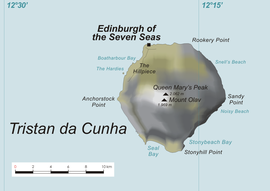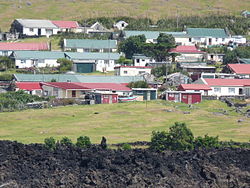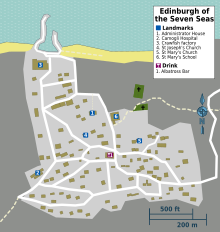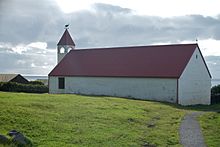Edinburgh of the Seven Seas
| Edinburgh of the Seven Seas | ||
|---|---|---|
|
|
||
| Coordinates | 37 ° 4 ′ S , 12 ° 19 ′ W | |
 Location of Edinburgh of the Seven Seas on Tristan da Cunha Location of Edinburgh of the Seven Seas on Tristan da Cunha
|
||
| Basic data | ||
| Country | St. Helena, Ascension and Tristan da Cunha | |
| Tristan da Cunha | ||
| ISO 3166-2 | SH-TA | |
| height | 40 m | |
| Residents | 245 (2020) | |
| founding | 1816 | |
| Website | www.tristandc.com/settlement.php (English) | |
|
View of Edinburgh of the Seven Seas
|
||
Edinburgh of the Seven Seas , also known locally as The Settlement , is the capital and administrative seat of the Tristan da Cunha archipelago , an equal part of the British Overseas Territory of St. Helena, Ascension and Tristan da Cunha . Apart from the South African weather station on Gough Island with a small permanent crew, Edinburgh is the only settlement in the archipelago . In August 2020 the place had a maximum of 245 inhabitants.
The name Edinburgh of the Seven Seas is derived from a visit by Prince Alfred, Duke of Edinburgh , on August 5, 1867. He visited the island during a world tour as the commander of the British frigate HMS Galatea .
geography
Edinburgh of the Seven Seas is located on the north coast of the island of Tristan da Cunha in the South Atlantic . It is approximately 2,800 kilometers from mainland Africa ( Cape Town ) and 3,250 kilometers from mainland South America ( Cabo Frio ). With the nearest inhabited location being 1,500 miles away on St. Helena , Edinburgh of the Seven Seas is considered the most isolated human settlement in the world.
The local area has an extension of about 600 meters. The southernmost point of the place is at a height of about 65 meters above sea level, with the terrain falling further and further north towards the coast. The rock walls of the volcano begin only a few hundred meters south of the settlement, the highest point of which is Queen Mary's Peak ( 2062 m ) in the middle of the island.
To the west of Edinburgh lies the delta of the Hottentot Gulch , one of the erosion gullies which, starting from Queen Mary's Peak, strive in all directions towards the sea and carry away the rainwater. There are numerous such drains on the island.
Population and culture
population
Edinburgh of the Seven Seas has a permanent population of 262 residents. Currently (as of 2017) there are around 80 families in the village, but only nine family names. The Glass, Swain, Rogers, Green, Hagan, Repetto and Lavarello families are of historical origin and were brought to the island by various settlers until 1893. The names Collins and Squibb were added later.
education
There are currently around 30 students aged 3 to 16 living in Edinburgh, all of whom attend St. Mary's School , the only school in town. The current school building was opened in 1975 and has five classrooms, two specialist rooms, a school kitchen and an auditorium. There are four classes at the school, which are divided according to age.
Infrastructure
The only link Edinburgh with the outside world is with Calshot Harbor of the port . With the Camogli Medical Center , the island is a private medical facility.
Attractions
Churches
There is an Anglican and a Catholic Church in Edinburgh . The Anglican Church of St. Mary's Church opened in July 1923. Before that, the services were held in the houses of individual islanders. The church bell and the wooden paneling inside were taken from a shipwreck . The church is also equipped with an organ and is partially surrounded by a low wall made of volcanic rock. In 1990/91 the church was expanded and modernized, the expansion of the sacristy was completed in 2002.
The Catholic Church of St. Joseph's Church was built in 1995/96 and replaces a smaller church built in 1983 on the same site. The Catholic Faith was brought to Tristan da Cunha by two Irish sisters in the early 20th century .
There is a two-part cemetery in the northeast of the village, near St. Mary's School .
Post office
Edinburgh has a post office that is located in one of the former station houses that were formerly intended for British immigrant families. Such houses were built in Great Britain and shipped in parts to Tristan da Cunha to be built there on a concrete foundation . Several thousand letters are processed in the post office every year. Mail is brought to the island exclusively by ship, after which it is sorted in the post office and then handed over to the recipients in Prince Philip Hall . The post office is mainly known to tourists for the Tristan da Cunhas stamps that can be purchased here. They are coveted by philatelists because of their rarity and are one of the most important sources of income in the tourism sector on the island. Post office employees sell the stamps on ships when they stop outside Edinburgh and passengers cannot go ashore.
More Attractions
The Tristan Island Museum has many exhibits that document the island's history. In addition to the museum, there is a craft shop in the house that sells various items made by the islanders as well as souvenirs . There is also a post office and a café here. Since 2012 there is another museum in the small town with the Thatched Roof House Museum .
The multi-purpose hall Prince Philip Hall , located in the center of the village, is one of the most important meeting points in the town and is also used for dance events at festivals. In the eastern part of the hall is the Albatross Bar , the only pub in town. The hall had to be refurbished in 2005 after being severely damaged in a hurricane in 2001. The roof was renewed and the facade was painted white. It reopened on September 18, 2005 with a dance event. Opposite the Prince Philip Hall is the local outdoor swimming pool.
Web links
- Tristan da Cunha Edinburgh of the Seven Seas. In: Tristan da Cunha website. Tristan da Cunha Government and Tristan da Cunha Association (English).
Individual evidence
- ↑ Population Update. Tristan da Cunha Government, August 21, 2020.
- ^ A b Tristan da Cunha Edinburgh of the Seven Seas. In: Tristan da Cunha website. Tristan da Cunha Government & Tristan da Cunha Association, accessed April 12, 2017 .
- ↑ Extreme Geography: The Most Remote Points in the World. Picture gallery. In: Welt Online . September 27, 2009, accessed on April 12, 2017 (with incorrect distance information).
- ^ Tristan da Cunha Visiting Tristan. In: Tristan da Cunha website. Tristan da Cunha Government & Tristan da Cunha Association, accessed April 12, 2017 .
- ^ Tristan da Cunha Island. Map of the island. In: Tristan da Cunha website. Tristan da Cunha Government & Tristan da Cunha Association, accessed April 12, 2017 .
- ↑ Tristan da Cunha Families. In: Tristan da Cunha website. Tristan da Cunha Government & Tristan da Cunha Association, accessed April 12, 2017 .
- ^ Education on Tristan da Cunha. In: Tristan da Cunha website. Tristan da Cunha Government & Tristan da Cunha Association, accessed April 12, 2017 .
- ^ Tristan da Cunha Camogli Hospital. In: Tristan da Cunha website. Tristan da Cunha Government & Tristan da Cunha Association, accessed April 12, 2017 .
- ↑ a b Tristan da Cunha Churches. In: Tristan da Cunha website. Tristan da Cunha Government & Tristan da Cunha Association, accessed April 12, 2017 .
- ↑ a b c d Tristan da Cunha Shops. In: Tristan da Cunha website. Tristan da Cunha Government & Tristan da Cunha Association, accessed April 12, 2017 .
- ↑ Our 3 Islands: Background Information on the Islands. St. Helena, Ascension and Tristan da Cunha Philatelic Society, accessed April 12, 2017 .
- ↑ BBC News : Country Profiles: St Helena, Ascension, Tristan da Cunha
- ^ Tristan da Cunha Prince Philip Hall. In: Tristan da Cunha website. Tristan da Cunha Government & Tristan da Cunha Association, accessed April 12, 2017 .




